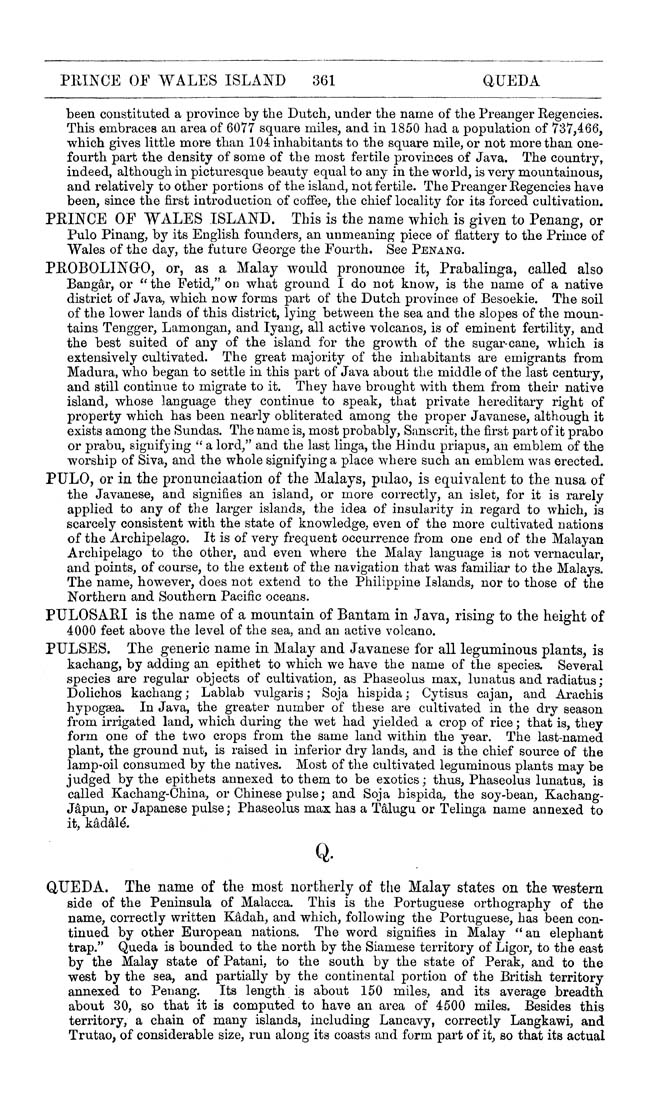PRINCE OF WALES ISLAND 361 QUEDA
been constituted a province by the Dutch, under the name of the Preanger Regencies.
This embraces an area of 6077 square miles, and in 1850 had a population of 737,466,
which gives little more than 104 inhabitants to the square mile, or not more than one-
fourth part the density of some of the most fertile provinces of Java. The country,
indeed, although in picturesque beauty equal to any in the world, is very mountainous,
and relatively to other portions of the island, not fertile. The Preanger Regencies have
been, since the first introduction of coffee, the chief locality for its forced cultivation.
PRINCE OF WALES ISLAND. This is the name which is given to Penang, or
Pulo Pinang, by its English founders, an unmeaning piece of flattery to the Prince of
Wales of the day, the future George the Fourth. See Penang.
PROBOLINGO, or, as a Malay would pronounce it, Prabalinga, called also
Bangar, or ^' the Fetid," on what ground I do not know, is the name of a native
district of Java, which now forms part of the Dutch province of Besoekie. The soil
of the lower lands of this district, lying between the sea and the slopes of the moun¬
tains Tengger, Lamongan, and lyang, all active volcanos, is of eminent fertility, and
the best suited of any of the island for the growth of the sugar-cane, which is
extensively cultivated. The great majority of the inhabitants are emigrants from
Madura, who began to settle in this part of Java about the middle of the last century,
and still continue to migrate to it. They have brought with them from their native
island, whose language they continue to speak, that private hereditary right of
property which has been nearly obliterated among the proper Javanese, although it
exists among the Sundas. The name is, most probably, Sanscrit, the first part of it prabo
or prabu, signifying " a lord," and the last linga, the Hindu priapus, an emblem of the
worship of Siva, and the whole signifying a place where such an emblem was erected.
PULO, or in the pronunciaation of the Malays, pulao, is equivalent to the nusa of
the Javanese, and signifies an island, or more correctly, an islet, for it is rarely
applied to any of the larger islands, the idea of insularity in regard to w^hich, is
scarcely consistent with the state of knowledge, even of the more cultivated nations
of the Archipelago. It is of very frequent occurrence from one end of the Malayan
Archipelago to the other, and even where the Malay language is not vernacular,
and points, of course, to the extent of the navigation that was familiar to the Malays.
The name, however, does not extend to the Philippine Islands, nor to those of the
Northern and Southern Pacific oceans.
PULOSARI is the name of a mountain of Bantam in Java, rising to the height of
4000 feet above the level of the sea, and an active volcano.
PULSES. The generic name in Malay and Javanese for all leguminous plants, is
kachang, by adding an epithet to which we have the name of the species. Several
species are regular objects of cultivation, as Phaseolus max, lunatus and radiatus ;
Dolichos kachang; Lablab vulgaris; Soja hispida; Cytisus cajan, and Arachis
hypogsea. In Java, the greater number of these are cultivated in the dry season
from irrigated land, which during the wet had yielded a crop of rice; that is, they
form one of the two crops from the same land within the year. The last-named
plant, the ground nut, is raised in inferior dry lands, and is the chief source of the
lamp-oil consumed by the natives. Most of the cultivated leguminous plants may be
judged by the epithets annexed to them to be exotics; thus, Phaseolus lunatus, is
called Kachang-China, or Chinese pulse; and Soja hispida, the soy-bean, Kachang-
J^pun, or Japanese pulse; Phaseolus max has a Telugu or Telinga name annexed to
it, kad^ld.
Q.
QUEDA. The name of the most northerly of the Malay states on the western
side of the Peninsula of Malacca. This is the Portuguese orthography of the
name, correctly written K^dah, and which, following the Portuguese, has been con¬
tinued by other European nations. The word signifies in Malay "an elephant
trap." Queda is bounded to the north by the Siamese territory of Ligor, to the east
by the Malay state of Patani, to the south by the state of Perak, and to the
west by the sea, and partially by the continental portion of the British territory
annexed to Penang. Its length is about 150 miles, and its average breadth
about 30, so that it is computed to have an area of 4500 miles. Besides this
territory, a chain of many islands, including Lancavy, correctly Langkawi, and
Trutao, of considerable size, run along its coasts and form part of it, so that its actual
|








